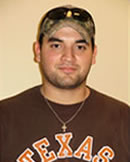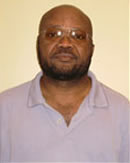Students
Current UTSA Fellows

Mary Berger
Project Title: Functional Studies of the Bipartite Begomovirus BR1 Promoter
Abstract: The begomovirus AL2 protein is required for activation of late viral promoters (AR1 and BR1), important for expression of two genes critical for virus survival. AR1 encodes the coat protein (CP) and BR1 encodes a protein essential for cell to cell movement. In this study we demonstrate that Tomato golden mosaic virus (TGMV) AL2 activates the BR1 promoter using a mechanism similar to that of the TGMV coat protein (CP) promoter. We have performed a limited deletion analysis, which has determined that sequences necessary for the AL2-mediated activation are located within 131bp of the BR1 coding region. To more accurately map the minimal sequence necessary and sufficient to activate the BR1 promoter, we are currently constructing five overlapping minimal promoter constructs, spanning 158nt of the BR1 promoter. Promoter-reporter constructs have also been introduced into Nicotiana benthamiana to determine the tissue specificity of the BR1 promoter. Initial analysis indicates that the BR1 promoter is active in phloem tissue in the absence of AL2. By comparison to the CP promoter this seems to indicate that the BR1 promoter is repressed in phloem and activated in mesophyll tissue. To identify viral sequences responsible for repression of the BR1 promoter in phloem, we have generated constructs containing the BR1 transcription termination sequence and produced transgenic plants.

Eric Botts
Project Title: The Effect of Competition and Availability of Water and Light on the Distribution of Verbesina virginica
Abstract: Verbesina virginica (Frost Weed) is a perennial herbaceous plant that occurs in areas across the eastern and central United States, including Bexar County, Texas. Verbesina virginica in central Texas is found almost exclusively in the understory of woodland habitats, and almost never in open grassland environments. Competition with fast – growing grasses and loss of water due to increased solar radiation are possible factors affecting its distribution. Greenhouse experiments will be performed in order to evaluate the effect of competition and light availability on V. virginica and a common annual grass, Bothriochloa ischaemum (K.R. Bluestem). Density gradient experiments will be performed on each species to evaluate growth. A DeWitt replacement experiment will be performed to evaluate growth under conditions of interspecific competition. Light gradient experiments will then be performed on V. virginica and B. ischaemum. Each species will be grown at a constant population density at specific light levels to evaluate their ability to grow under shaded and unshaded conditions. Another light gradient experiment will be performed in which the two species are grown together at a constant ratio at specific light levels. These experiments will demonstrate intraspecific and interspecific competitive ability of the species under different light conditions. Aboveground and belowground dry mass, basal diameter, stem/leaf length, and leaf count will be measured in all growth experiments. Field studies will be performed in a habitat in northern Bexar County, Texas at a site where established woodland with tree canopy coverage borders open grassland. Xylem water potential and photosynthesis rates of V. virginica will be measured. Through these experiments, growth of V. virginica under competitive pressure from a common Texas grass, as well as under conditions of open grassland and shaded understory will be observed in order to better understand the cause of its local distribution.

Fabiola Contreras
Project Title: Transcriptional analysis of insect elicitor-induced distant signaling in Zea mays
Abstract: To characterize distant signaling in plants induced by mechanical wounding and insect-derived elicitors we studied defense gene expression in different sections of the damaged leaf as well as in systemic parts of three week-old seedlings of Zea mays. Genes selected were chosen based on their potential involvement in signaling (allene oxide synthase, AOS), regulation of gene expression (transcription factor MYC7), and in direct defenses (ribosome inactivating protein, RIP). Transcript abundance of these genes was measured by semi-quantitative polymerase chain reaction (PCR) at different time points. First results showed the highest levels of transcripts for all tested genes after treatment with insect elicitor when compared to mechanical damage and controls. For insect elicitor treatment we found higher levels in the local and distal segments of the leaf, whereas in basal segment only minor changes were detected. For mechanical wounding the highest abundance for transcripts was found in the local segment, but significant increases could also be detected in the basal and distal segments of the leaf. For the systemic response we could only detect an increase of MYC7 transcripts 60 min after treatment with insect elicitors. By comparing these results with previous studies on distant signaling in Zea mays two conclusions can be drawn: (I), the highest transcript abundance correlates with jasmonic acid (JA) levels in the corresponding segments, and (II) a significant increase in transcripts, although on a much lower level, could also be detected in those segments that did not show any significant increases in (JA) after the above-described treatments. These results imply alternative signaling pathways yet to be discovered.

Terri Matiella
Project Title: The Effects of Carbon Dioxide and Air Pollution on Milkweed (Asclepiadaceae) and Monarch Butterfly (Danaus) Larva
Abstract: In the greenhouse the effects of three levels of carbon dioxide, (ambient, elevated and 2 times elevated levels) on the growth of three species of milkweed (Asclepiadaceae) and monarch butterfly larvae (Danaus plexippus) will be examined. Plants will be grown under varying carbon dioxide levels for eight weeks and various growth parameters measured. Larvae will be given a choice of either plants grown at subambient, ambient, or elevated, and feeding preference determined. The larvae will be raised to adulthood on leaf material from plants in each treatment level, and changes in weight, length of instar stages and mortality noted. Leaf tissue will be analyzed for chemical changes across carbon dioxide levels. In the field, milkweed plants at two sites will be examined, one site with consistently high levels of air pollutants, and the other site with consistently normal or lower levels of air pollutants and various growth parameters measured. Natural monarch butterfly larvae populations will be monitored for mortality and a sample will be taken for determining feeding preference between field site plants. My hypothesis is plants exposed to higher levels of carbon dioxide will show poor performance as related to growth, and have lower overall mass. Chemical changes will make these plants a less suitable host plant for monarch butterfly larva; larva will perform poorly on them, and show less health and higher mortality. For field experiments, I propose to see the same trends in plants grown in areas of consistently higher air pollutants.

Terri Nelson-Dickinson
Project Title: Abiotic and biotic factors affecting the growth and survival of Acer grandidentatum, Bigtooth Maple
Abstract: This project will consider several factors that affect seedling growth and survival of Acer grandidentatum. First, the plant communities where Acer grandidentatum is found will be examined. A riparian community, a hilltop community and a deer exclosure at Lost Maples State Natural Area will be examined. The quadrat method will be used. Next, thirty first year seedlings will be transplanted to the field, fifteen inside and fifteen outside an exclosure. Survival and growth rates will be compared between the groups. Third, seedlings will be transplanted into pots in a three factor greenhouse experiment comparing the interaction of nutrients, competition, and simulated herbivory. Fourth, the Li-Cor®6400 portable photosynthetic meter will be used to measure photosynthetic rates of sun and shade maple leaves in the field and to generate photosynthetic light response curves. Finally, twenty seedlings will be grown in pots at 30%, 60%, 80%, and 100% ambient lighting and growth rates will be compared.

Ezenwanyi Onwuchekwa
Project Title: A Preliminary View of Climate Change from Satellite-Derived Water Level Time Series of Lake Chad
Abstract: Lake Chad is located in Africa. It is bordered by four West African countries: Nigeria, Niger, Chad, and Cameroon. Lake Chad was at a time one of largest bodies of fresh water in Africa and has decreased in size due to an increasingly dry climate and human demands for irrigation water. The purpose of the study is to use Satellite altimetry data measure the water level and its change during the recent over 10 years. TOPEX/POSEIDON (T/P) and Jason-1 have continuous data since 1993 and ICESat (ice, cloud, and land elevation satellite)/GLAS (the geosciences laser altimeter system) are available during 2003- 2008. This research will help to understand how climate change may have been impacted the regional economic and agriculture.

David Prado
Project Title: Characterizing Urban Heat Island Phenomenon of Four Texas Cities Using Modis Lst Products
Abstract: In this study, MODIS's (Moderate Resolution Imaging Spectroradiometer – Earth Observing System) land surface temperature (LST) products of eight-day composite images at 10:30 am, 1:30 pm, 10:30 pm, and 1:30 am are used to study urban heat island (UHI) phenomenon over four major Texas cities (El Paso, Dallas-Ft. Worth, Houston, and San Antonio) from the Summer of 2000 to the Fall of 2008. The eight-day LST products are used to generate spatial maps characterizing the temperature distribution and UHI spatial extent for each city.
The results indicate that (1) UHI can be observed in night time images in Dallas-Ft. Worth, Houston, and San Antonio all year long; the intensities of UHI are larger in night times of spring and summer seasons than those of fall and winter seasons; (2) UHI consistently appears in night time images in El Paso-Juarez and the intensities of UHI are similar in all seasons; (3) the day time images contain large amounts of cloud contamination in Dallas-Ft. Worth, Houston, and San Antonio which make the use of day time images to map UHIs in those cities difficult; and (4) from the temperature climatology maps (seasonal mean and yearly mean) of the 8 years, it is found that Aqua/MODIS LST products in the night time (1:30 am) is the best for mapping UHI for all four cities and that the spatial extent and pattern of the UHI differs from the expected HI usually centered in downtown of a city.

Jessica Valdez
Project Title: Beetle Seed Predation of the Acacia farnesiana (Huisache) in South Texas
Abstract: Many Acacia (family Fabaceae) are subjected to infestation by bruchid beetles of the family Bruchidae (Coleoptera). Predation by bruchid beetles, which lay their eggs on ripening pods, has been shown to cause a negative effect of seed viability. The larvae drill into the seeds, and feed on the embryo and endosperm. Acacia farnesiana, a woody legume in the Fabaceae family, has characteristics which attract beetles. Oncideres pustulata (huisache girdler) is known to girdle on the branches of the huisache tree, and bruchid species have been shown to infest huisache seeds in central America. In this study, we will survey beetles which are associated with various phases of huisache development in south central Texas. Beetles which occur on huisache will be determined using sweep net sampling. Those underneath adult huisache will be sampled using pitfall traps. Huisache seeds will be collected and incubated to determine the species which infest the seeds. Seed production will be determined by measuring the seed rain using a tree canopy method. Species of beetles which infest the seeds will be determined, the degree of infestation measured, and the effects of this infestation on seed viability.
Former UTSA Fellows

Grisel Acosta
Project Title: Negotiating Environments: Urban and Rural Tension and Balance in U.S. Caribbean Latino/a (Con)Texts on the East Coast
Abstract: The work of Piri Thomas, Sandra Maria Esteves, Pedro Pietri, Judith Ortiz Cofer, Junot Diaz, Achy Obejas, Willie Perdomo and Angie Cruz, among others, places U.S. Caribbean Latino/a subjects in a context of tension where they negotiate the positive and negative aspects of migrating back and forth from rural and urban environments. These Latinos/as have traditionally been exposed to hazardous environments because of poverty and pollution, and the (con)texts they find themselves in are comprehensive examples of the timeline of environmental justice issues this population has historically faced. The authors mentioned have recorded this history in their creative and autobiographical works. However, in addition to recording the difficult adjustment to these environments, the authors have also recorded the negotiation and, often, resulting balance that can occur when such environments are understood, protected and utilized by U.S. Caribbean peoples.

Fernando Martinez
Project Title: Herbivory Effects on Quercus Species
Abstract: Although much has been described about the replacement dynamics of woody species within various types of established communities, mechanisms of replacement dynamics for some communities is equivocal. A major conservation and management need is to better understand patterns and variations in tree recruitment and also the processes that affect the timing and success of regeneration. For example, many Quercus communities in North America exhibit recruitment failure. In past research, high Quercus seedling densities have been reported, which typically supports suggestions that seed production, seed germination, and seedling recruitment were not a problem in the past, however current demographics indicate a lack of juveniles. While light intensity has been shown to be a potential factor affecting regeneration in Quercus communities, the impact of ungulates on the regeneration of Quercus communities is largely under-described. Monitoring distribution patterns of local herbivore communities and their impact on Quercus demographics may lead to a better understanding of the potential interactions between herbivores and vegetative communities. Wire mesh enclosures will be used to protect Quercus juveniles on the Kerr Wildlife Management Area (Hunt, Texas) for five treatments, including: control, natural herbivory, and simulated herbivory (33, 66, 100% vegetation removal). Measurements such as stem length, stem counts, leaf counts, basal circumference, maximum photosynthetic rates, and above ground nitrogen content will be compared across treatments. It is speculated that herbivores depend heavily on the newly emerged seedlings and saplings as late summer, fall and winter browse. With the speculated foraging rates, it would stand to reason that the recent observation in recruitment failure in Quercus communities would often be a direct result of herbivore foraging. Browsing of Quercus species by herbivore populations is a commonly known occurrence; however the amount or impact of foraging pressure on sensitive Quercus communities is likely largely unknown.

Crystal Mendez
Project Title: Sampling Survey and Population Dynamics on the Fish of Mitchell Lake
Abstract: The reservoir stretches over 600 acres and contains polders, ponds, basins, and water discharged from a local wastewater recycling center. The reservoir has a long history and was purchased by a family back in the 1800's. In the early 20th century, it was known as a private duck-hunting site for residents near by. The reservoir was purchased in the 1930's and became part of the wastewater treatment facilities in south Texas, and was used primarily as a sludge disposal lake until 1987. Since then, the reservoir has been known to be a watering hole and stopping point for many migratory birds, shore birds, and waterfowl. In 1973 the reservoir was declared a Wildlife Refuge and has documented up to 307 bird species visiting the reservoir, which attracts many birdwatchers to the site. The reservoir contains high of levels of nutrients and is also known to be a home to fish and a booming population of turtles. Fish are good indicator species, and can be studied to determine the health of ecosystem. The goal of this project is to monitor the health of the fish and how their standard of living can be improved to support the diverse species living within the reservoir ecosystem. With data collected as part of this study, the Audubon Center and SAWS would have a baseline understanding of the diversity and number of fish living within the reservoir.

Elizabeth A. Murphy
Project Title: Ocean Heat Flux under Sea Ice in the Southern Ocean, Antarctica
Abstract: The relationship between ocean heat flux and ice undersurface melting rate plays an integral role in determining the character of the sea ice cover. This relationship also is ultimately a piece of global climate, as melted ice or variations ins ice growth affect the density profile of surface waters, thereby influencing potential ocean mixing. In October 2007, we installed an Ice Mass Balance Buoy (IMB) at a sea ice drift station in the Bellingshausen Sea. Average ocean heat flux over the study period was derived from the ice thickness changes measured by an upward looking acoustic sensor below the ice. The ice thickness changes were dominated by ice melting, and gave an average estimate of ocean heat flux to the ice of about 8 Watts mˉ². Additionally, elevation of the surface water temperature above its freezing point was computed from bihourly Sea-Bird Conductivity-Temperature-Depth (CTD) measurements. And the relative speed of ice drift was computed from Global Positioning System (GPS) data. The sea surface temperature elevation above freezing point, as an approximation of available heat content, and relative speed of the ice drift, as an approximation of turbulent stress, were used to parameterize ocean heat flux directly from the ocean measurements. The average value of ocean heat flux calculated from the bihourly ocean measurements was about 7 Watts mˉ². While the mean heat flux determined by the two methods was similar, the latter method revealed temporal variability that the former could not. This more detailed picture of ocean heat flux dynamics gives better physical insight into the process of heat transfer between the ocean and the ice cover. Further work on ocean heat flux will be conducted using the full set of IMB data from the Bellingshausen Sea region, the Southern Ocean Global Ocean Ecosystems (SO GLOBEC) buoys (2002 and 2003) from Marguerite Bay, and a February 2009 IMB deployment in the Amundsen Sea.

Emeka Ovuegbe
Project Title: A Field-Based Study of the Effects of Spatial and Temporal Variability on Water Quality along Geronimo Creek Watershed in Guadalupe County, Texas
Abstract: Water is a finite resource and sustaining its quality and quantity is a major concern confronting the world today. Communities with water quality related problems, including the Latinos, are at risk of famine disease because of inadequate and/or poor quality water supply. High population growth, cost of mining, processing and delivery of water, water related human behaviors and needs, are some of the reasons why efforts are on going to address these challenges through source monitoring and management, recycling, conservation, substitution and reuse among others. My research project is a multi-parameter "impaired" Geronimo Creek (about 17 miles) located in Geronimo City in Texas, United States with a historically sizeable Hispanic population. The 2004 Texas Water Quality Inventory (TWQI) and 303(d) List reported the entire segment of Geronimo Creek as impaired for high concentrations of E. coli bacteria while the Draft 2006 Assessment also documented high and increasing nitrate-nitrogen levels. Excess nitrogen and phosphorous has effects on the quality of surface and ground waters and can cause water systems to become eutrophic resulting in decreased oxygen level and also contribute to increased suspended sediments. Nitrogen as nitrate above the current drinking water standard of 10mg/L (USEPA) is unsafe to humans and a risk factor for infant methemoglobinemia (blue baby syndrome), which if untreated and with increasing severity may result in coma and death. E. coli Bacteria are used as an indicator of the possible presence of disease-causing organisms. Annual metals sampling by Guadalupe-Blanco River Authority/Texas Clean Rivers Program (GBRA/TCRP) found a high mean total Selenium (Se) concentration of 2.07 µg/L as well. My research, therefore, is a consequence of the need for a more detailed study of the water quality of Geronimo Creek in order to address the several questions and concerns being raised on these estimates and their likely sources. The outcome will serve as a benchmark data inventory of the creek for all authorities and as a reference tool for decision actions by TCRP, the Texas Commission on Environmental Quality (TECQ) and the United States Environmental Protection Agency (USEPA) in their comprehensive resource planning and management strategies. Study result will potentially be helpful in the development and approval of a Watershed Protection Plan (WPP) for Geronimo Creek; and GBRA's long-term water quality and aquatic ecosystem planning and sustainability. It will also be central in development of necessary best management practices (BMP) necessary in solving the reported water quality issues and effectively maximize the safety and use of the stream among the catchment Hispanic communities.

Anne Perry
Project Title: Effects of Increased Carbon Dioxide Levels in Grassland Establishment
Abstract: Grassland biomass, density and cover decline as woody species encroach into grasslands. Biomass is shifted from being concentrated belowground to aboveground and species richness and diversity decline. It is critical to understand conditions required to promote grass growth to maintaining these grasslands. Woody plants are normally suppressed by the competition they face with grasses. Changes in the distribution of grasslands naturally occur, however, over the past 160 years the changes have been unprecedented. These changes have multiple causes, primarily the constant herbivory from domestic animals, but also includes the reduction of fire frequency. It is apparent that there is also another variable that may come into play in the future, increasing levels of carbon dioxide. The ambient levels of carbon dioxide have increased to 390 ppm and are expected to continue to rise to over 800 ppm by 2100. By studying the effects of increased carbon dioxide on competition between grasses and woody plants this will allow for better understanding of grass and woody plant growth and the potential for prediction of the future of many grasslands. In the following experiments competition between Bouteloua cutipendula, side oats grama, a C4 grass, and Prosopis glandulosa, honey mesquite, a C3 woody plant will be studied.







